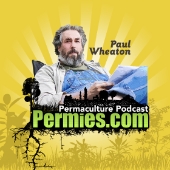Hmmm....
I guess I'll wade in and try to respond to some of this. As a "traditionally schooled" (read Society of American Foresters accredited B.S.F and M.S.F) I was long steeped in the "right" way to do forestry. Since the schooling i have had a good chance to broaden my horizons. I think differently than many foresters when it comes to forest and land management, and I can attest that most agencies are very insular in their thinking and new ideas are rarely allowed to spread.
I think the way to look at professional forestry advice v.s. a permaculture approach would be similar to a the advice you might receive from the USDA farm service center for traditional agriculture vs. permaculture. Both groups are schooled in a production orientation that does not take into account many of the permaculture ideas. As opposed to putting my foot in my mouth I will simply pose that many folks will not accept that permaculture can be as productive as high intensity row cropping (though clearly there are many metrics where this is not true)...these same breed would say that agro-forestry, food forests, and even many methods of non-even-aged (anything but clear cuts) management cannot be more productive, valuable, or even valid as management options compared to plantations or intensive even-aged management. I have experienced both sides growing up in traditional Ag and being schooling and working in Forestry. The mindset of permaculture valuing things like Honey locusts does not mesh with the mindset of commercially valuable timber species (most loggers won't cut them and most mills wouldn't pay for them if they did). The mind set of being willing to chop and drop multiple times a year because it works and it is better for the system does not mesh with a though process that would use chemicals simply because they exist and they kill everything except your end crop. I am not certain that I have good advice on how you might filter out the advice you were given. In general I would recommend you run with your current ideas since it is your land and you clearly have reservations on the advice given. I do still have concerns with animals in the woods which I will mention below.
Dave,
The forester, and other forestry information I've read, are emphatic that "weed control" around new tree plantings is the most critical factor in the success (or lack) of tree survival.
There are many many studies to back this up. But, most of those are built on the premise that the landowner wants to put slightly less than zero additional effort into the site post year 3 or 4. Honestly, many folks would never dream of actually implementing a "chop and drop" program. And most folks don't care if you use chemicals on their land. In my opinion what you propose would lead to very similar results as using weed mats, mulch, or disking/tilling. There is a quote I enjoy from Geoff Lawton (I believe it was from a Survival Podcast interview) where he was asked about growing "invasive and non-native species" and how he justified that to people with concerns. His response was simply "I don't know any tree or shrub that can out run my bill hook". I don't think non-permanculture people would understand that since very few would ever think of actively managing a woodland or forest to that degree. I think your idea of regularly pruning back the "undesirables" would work great and it would likely eventually kill off the ones you chopped the hardest/most often. I agree that the forester was trying to save you frustration, but that doesn't mean he was right.
However, putting any livestock on the property makes it ineligible, and if already enrolled in the program, subject to fines and back taxes
I have done quite a bit of private forestry consulting and in Missouri it is the norm that cattle are allowed to run in the timber as well as the pasture, mostly in a few large pastures with very little rotation. This results in nearly all seedlings being grazed until they die, it also results in nearly all acorns being eaten. Since the woods are not allowed much in the way of recovery the long term result has been a shift towards hickory dominated woods in many pastures, cattle can't crack the nut and seem to dislike the seedlings. In Virginia I noticed it leads to more Tulip poplar (tiny wind born seeds cannot be eaten by cattle I am guessing). Some folks could say this is okay but when coupled with the soil compaction that leads to additional erosion and the removal of most understory and midstory species which seems to lead to a complete atrophy of forest duff and soil formation the end result is a pretty sad patch of trees.
Now before the crucifixion begins, please understand that I do think grazing in timber and riparian areas can be done responsibly and can lead to overall system benefits. Specifically when done in quick rotation with other pasture and when it is understood that soil compaction and herbaceous recruitment are important inside the woods too. Many pastures in Missouri are badly mismanaged and many of the woods are heavily grazed, and in the short run the land suffers more than the people so I can see why the blanket of the incentives is to avoid livestock in the woods completely.
Sorry if this turned out to be more rambling than helpful, but I have spent a great deal of time trying to mesh my schooling in forestry with my understanding of permaculture and in the end the two disciplines approach a problem from such different angles that it can be hard to see where the two might naturally complement each other. There are spaces I have found, but it will take a brilliance I lack to better answer your question.
J













 1
1
















 1
1






















